.
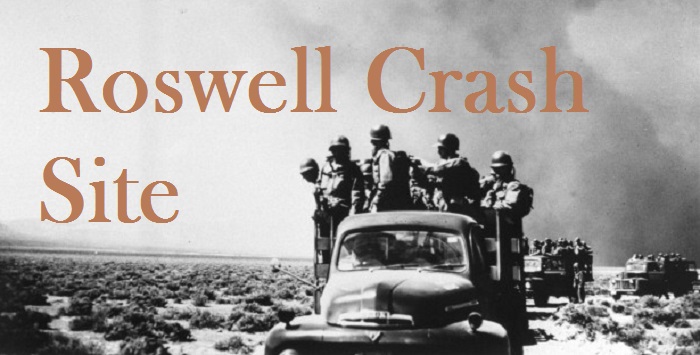
.
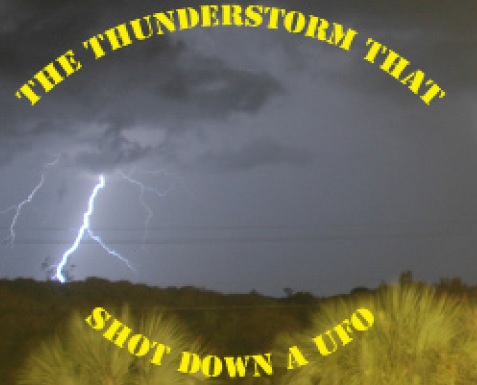
In the book, The Roswell Incident, the demise of the alien spaceship is linked to a freak thunderstorm that appeared over central New Mexico. Bill Brazel relates what transpired:
Dad was in the ranch house with two of the younger kids late one evening when a terrible lightning storm came up. He said it was the worst lightning storm he had ever seen [and you can be sure he had seen a lot of them], not much rain with it, just lightning--strike after strike....in the middle of this storm there was an odd sort of explosion, not like the ordinary thunder, but different....1
So began the legend of the thunderstorm that signified the crash of an alien spaceship. In the same book, Jesse Marcel would state:
It seems to me that Brazel told me that he thought he heard an odd explosion late in the evening several days earlier during an electrical storm, but paid no special attention to it at the time....2
His description of what transpired is somewhat different in an interview with Bob Pratt:
I faintly remember he told me he heard an explosion at night and the following day he went out there in that direction and he saw that stuff.3
Missing is the part of the lightning/thunderstorm. It is possible that Moore might have told Marcel about Bill Brazel’s story or vice versa, which resulted in some contamination of their testimony. Marcel would mention the storm story again to Linda Corley.
Some have suggested that the thunder/lightning storm actually caused the crash, while others suggest it was just coincidental. Over the years, people have tried to look for records of this thunderstorm. In the book, The UFO crash at Roswell, Don Schmitt and Kevin Randle wrote:
According to meteorological records, on the evening of July 2, 1947 a thunderstorm hit the vicinity of Corona, New Mexico. 4
No specific weather records are cited or presented for this claim. Karl Pflock would write there were no records of any significant thunderstorms:
...official National Weather Service records have established beyond any doubt that the only thunderstorm activity anywhere in all of southeastern and south-central New Mexico from July 2 and July 7 was at Alamogordo the afternoon of July 2, with a trace of rain reported at Cloudcroft on the same date, both locations far distant from the site north of Roswell.5
Meanwhile, David Rudiak has made the claim that there was thunderstorm activity in the vicinity of the Foster Ranch on July 2nd and July 4th. His evidence appears to be from newspapers from the time period.
Based on these claims, I decided to check the weather data using the media accounts at the time. In SUNlite 2-5, I mentioned some of this but I wanted to look a little closer. I once again checked the Albuquerque Journal weather observations from across the state for those dates (see below), the historical weather maps (see July 1-5 maps on page 16), and even the forecasts from the Albuquerque Journal. The forecasts are really not very informative. Most of the time it states that there would be widely scattered or occasional thunderstorms (See July 2nd Albuquerque Journal weather forecast to the right). The weather reports are more informative. However, the only significant rainfall during this time period seems to have occurred in the northeastern part of the state. Clayton, NM (over 200 miles from the Foster Ranch) received 1.49 inches of rain on the 2nd of July. The stations near the Foster Ranch (Albuquerque, Carrizozo, and Roswell) report only a miniscule amount of rain on the 1st. Albuquerque did report a trace on the 4th but the other two stations recorded none with observations of “Clear” and “Partlycloudy” skies. This is consistent with what the historical weather maps for the time period show:
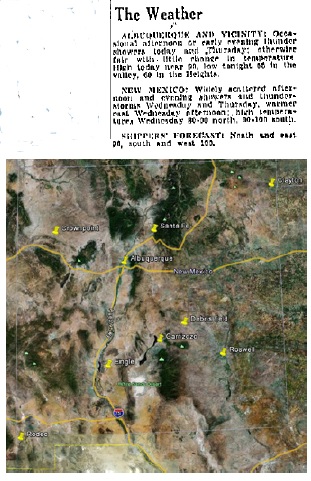
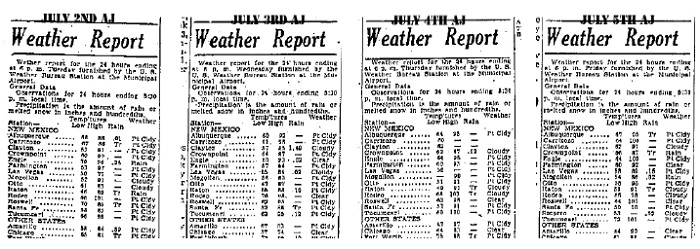
.

I also checked the weather underground web site and found hourly observations for Roswell and Albuquerque. The only observations of thunderstorms between July 1 and 4, were Roswell on July 1st at 2:00 PM and Albuquerque on July 1st at 3:00 and 4:00 PM. This confirms the weather observations listed in the Albuquerque Tribune for July 2-5, which states the only time any rain was recorded at these locations was on the first of July (see observations from the July 2nd paper).
In another attempt to identify significant thunderstorm activity in early July of 1947, I decided to consult the July 1947 Monthly Weather Review. It listed all the recorded significant storm activity in the United States for July of 1947.
.
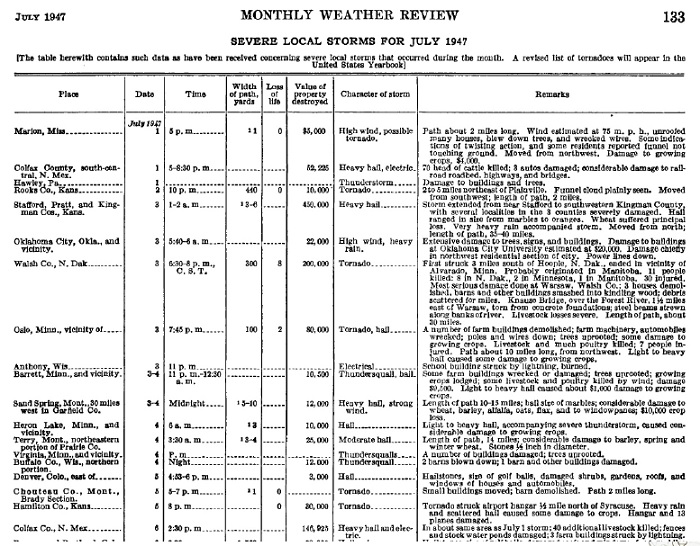
Notice that there is no record of any significant thunderstorm activity in New Mexico for early July of 1947 except for Colfax County (which is in the northern part of the state, the “south-central” statement is for the location in the county) on the 1st and 6th of July. This is also consistent with what was reported in the Albuquerque Journal.
The same journal presents a map showing the rainfall in New Mexico for the month (see image to the right). This is probably from the same stations recorded in the Albuquerque Journal. The amount of rainfall for central NewMexico was around 1-inch. There were significant thunderstorms in mid-month according to the severe storm table and Albuquerque Journal weather records. There was a heavy storm on the 17th in Mountainair, NM and Carrizozo recorded 0.71 inches on the 16th and 0.12 inches on the 17th.
All of this indicates that there were no significant thunderstorms in New Mexico between the evening of July 2nd and July 4th, which is when the event supposedly occurred. While we can not rule out the possibility that an isolated thunderstorm did appear, we also can state that there is no evidence in the records that such a storm positively occurred over the Foster Ranch during that week. All we have are decades old stories that there was a thunderstorm in early July that coincided (or possibly caused) the crash of “the flying disc”. The weather record does not support this claim and Roswell investigators should either produce the records they claim exist or concede the idea that a thunderstorm was involved is unlikely.
Notes and References
Berlitz, Charles and William Moore. 1. The Roswell Incident. New York: Berkley, 1988. P. 85.
ibid. P. 71 2.
Pflock, Karl. 3. Roswell: Inconvenient Facts and the Will to Believe. Amherst: Prometheus, 2001. P 230.
Randle, Kevin and Donald Schmitt. 4. UFO Crash at Roswell. New York: Avon, 1991. P. 37.
Pflock, Karl. 5. Roswell: Inconvenient Facts and the Will to Believe. Amherst: Prometheus, 2001. P 54.
-

I was watching a NOVA program called “Crash of flight 447” one day and they discussed if it was possible that an airplane could be taken out by a bolt of lightning. According to the program, planes are struck by lightning at least once a year. They even produced a video of an airplane being struck by lightning while in flight (see image to the right). While these pilots were probably very alarmed by the event, the plane appeared to continue on its flight unaffected. Apparently, the design of our airplanes makes it difficult for a bolt of lightning to take out an aircraft.
One can add to this bit of information the launch of Apollo 12, which was stuck by lightning twice after liftoff! Despite this almost catastrophic event, the mission continued and the spacecraft was not permanently damaged.
This brings into question the idea that a lightning strike could have destroyed an advanced alien spaceship. Earthly spaceships and aircraft seem to have no problems handling such an event. Why would this alien spaceship be unable to handle this expected situation? Have any other alien spaceships been destroyed by lightning? It is one of those perplexing mysteries surrounding the supposed crash of an alien spaceship near Roswell.
.
The Cluster of balloons
.
One of the endless arguments concerning the New York University flight #4 hypotheses for explaining the Roswell debris has to do with the existence of flight #4, what materials it had, and could the wind data support a flight to the Foster Ranch. Back in 1997, Professor Charles Moore wrote a section in the book “UFO Crash at Roswell: Genesis of a modern myth”, which tried to answer these arguments. However, UFOlogists have raised some questions that are worth examining about these balloons and if it was possible that the flight could have produced the debris.
Crary’s journal
The documented record is clear that flight #5 was launched on June 5th, 1947 but there is no real record of flight #4. According to Professor Charles Moore, it was not recorded because they could not obtain useful tracking/altitude data from the flight. So, while it was launched/planned, it failed to be listed in the official documentation. However, there is an entry in Dr. Crary’ journal that indicates when flight #4 might have been launched:
Jun 4 Wed. Out to Tularosa Range and fired charges between 00 and 06 this am. No balloon flights again on account of clouds. Flew regular sonobuoy up in cluster of balloons and had good luck on receiver on ground but poor on plane. Out with Thompson pm. Shot charges from 1800 to 2400. 1
At first glance, this indicates that a flight had been canceled and another flight had been launched with a sonobuoy microphone. Professor Moore stated that this entry was taken from Crary’s handwritten field notes and recorded as one item. He interpreted this to mean that a flight had been planned sometime in the middle of the night but clouds had delayed the launching. Once the weather was clear enough, the flight was then launched.
There are some notes in Crary’s journal to support the idea that they had planned a middle of the night balloon launch on their first attempt. He states on June 2nd:
Changed shooting plans to coordinate with balloon flights.2
On June 3rd, he wrote:
Up at 2:30 am ready to fly balloon but abandoned due to cloudy skies.3
On June 5th, he wrote the following in regards to flight #5, which would be launched around sunrise at 0500:
Up at 4 to shoot two charges for balloon flight. 4
This means the charges he set off between midnight and 6 AM in his June 4th entry may have been to coincide with a balloon flight. Moore’s analysis of the weather indicates there were clouds in the area until the early morning and it might have cleared enough for a launch as early as 3AM.
Was it just a microphone?
Flight #4 opponents’ argue that Moore’s interpretation is not correct. They read the entry to mean that the constant level flight configuration had been canceled. The balloon train was then stripped of equipment, and the resultant flight only had a microphone attached. As a result, the only thing sent up was a scaled down flight that had no radar reflectors.
We will never know exactly one way or the other what was on this “cluster of balloons” but there are possibilities that both sides have not considered. As a result, I present the following possible explanation for the “cluster of balloons” flight.
0000 Flight #4 was to be launched but the weather did not support it. Because it was being launched at night, it would have been difficult to track the flight visually even with a nearly full moon present. Prior to radar, it was standard procedure to put a paper lantern with a candle on weather balloons for visual tracking purposes at night. However, that would not be possible with an NYU flight. The possibility that the SCR-584 could track the balloons was not ignored by the team and they probably decided to use the same types of radar reflectors that planned to use on flight #2. Since the weather did not support the launch of the flight at midnight, it was either canceled or delayed.
0300-0600 At some point the weather cleared enough to attempt a launch. If the flight had been canceled, as stated, the balloons would either have been released or used for the flight with the microphone. Assuming that these balloons were used with themicrophone, flight #4 opponents state that everything else would have been stripped off the train because that is what Professor Moore had stated would happen in the event of a canceled flight. It is possible that this might have happened but not to the extent that is stated where only balloons and a microphone were launched. The radar reflectors could have remained on the ‘cluster of balloons” for several reasons:
1. They were expendable items that were not that important for use on the next flight.
2. They were needed to track the balloon flight with the radar if it was still dark.
3. It would be a good test of how good the SCR-584 tracking was for future use in balloon flights.
What may have been removed were the items that would be necessary for the next flight such as the radiosonde and “dribbler” for maintaining altitude. The more items that were stripped from the flight, the more lift the assembly would have. If no balloons were removed to compensate, then the flight would have risen at a much higher rate than planned. All of this would affect the computed trajectory of this “cluster of balloons”.
The cluster of balloons with a sonobuoy was never recovered as far as anyone can tell. The plane gave up the chase when it could not receive a signal. It probably left the range of the SCR-584 radar (about 40 miles) shortly after launch. Professor Moore stated the operators also had trouble tracking the balloon flights even when they had reflectors. It appears that the use of the one short range radar was inadequate to track these balloon flights and the use of radar reflectors would be worthless until they received radar equipment that could track the flights further downwind. As a result, flights 5 and 6 had no radar reflectors and were apparently launched around sunrise in order to allow visual tracking. The next flight that was launched before sunrise was flight #8 in July. It was launched around 3AM and was tracked with radar because it remained in the vicinity of Alamogordo.
Footprints in the desert
The flight path for this “cluster of balloons” that was launched on June 4th has been a point of contention by many UFOlogists. There have been accusations that Professor Charles Moore had intentionally falsified the data in order to compute the trajectory he desired. Dave Thomas wrote in SUNlite 2-3 that Moore did no such thing and Moore had told him:
...the publishers of the Saler/ Ziegler/Moore book mangled the table of values explaining the MOGUL trajectory calculations, and mashed together alternating rows into single, garbled rows of data.5
In either case, the table has errors in it that appear to invalidate the work. Meanwhile, UFOlogists have computed their own trajectories and have implied it is impossible for the flight to have made it to the ranch.
Many years ago, I spent a great deal of time computing various possible trajectories for this flight by varying the different factors that could affect the flight path. On several occasions I had the balloons landing within a few miles of the Foster Ranch. Other variations had the balloons landing in various places dozens of miles of the Foster Ranch giving me the impression that it was possible that these variables produced a general “footprint” of potential landing sites. That “footprint” could include the Foster Ranch. As noted by Professor Moore, the winds do tend to support a trajectory towards the Foster Ranch. The surface winds measured at the time (heading in a direction of about 45-65 degrees azimuth) in conjunction with the stratospheric winds (which were blowing towards the WNW) indicate this trajectory is possible. Variables such as the rate at which the balloons rose, the actual altitude where the winds shifted, the length of time the balloons lasted before bursting, the descent rate of the balloons, and the actual wind speeds at the time can affect the balloon flight and where it might have landed. One can not conclusively state if this “cluster of balloons” made it to the Foster Ranch or not. However, as noted by Professor Moore, the description by Mack Brazel seems to indicate the recovery of an NYU team balloon train made up of neoprene balloons and radar reflectors. A coincidence that it hard to dismiss.
Notes and References
HQ USAF, The Roswell Report: Fact vs. Fiction in the New Mexico Desert. Washington D.C.: US Government, 1995 attachment 1. 32/Appendix 17.
.
The crash site and the materials
.
One of the most interesting interpretations concerning the Foster Ranch debris field and debris is how the story evolved over the years and different writers have interpreted the testimony and accounts. In 1947, the documented statements by Marcel and Brazel indicated a debris field consisting mostly of sticks, tape, rubber, and paper-backed tin foil. However, this description would change thirty years later.
The gouge/debris field
In the late 1970s, Jesse Marcel Sr., Bill Brazel, and Bessie Brazel were first interviewed regarding the debris field. While the book, The Roswell Incident, asserted that the UFO had dug up the ground, this is not what these individuals stated:
Jesse Marcel’s description of the debris field contradicted the conclusion that a gouge was present:
Whatever it was had to have exploded in the air above ground level. It had disintegrated before it hit the ground. The wreckage was scattered over an area of about three quarters of a mile long and several hundred feet wide. 1
...nothing actually hit the ground, bounced on the ground. It was something that must have exploded above ground and fell...scattered all over. Just like you’d explode something above the ground and just fall to the ground... It was traveling from north-east to south-west, it was in that pattern, you could tell where it started and where it ended by how it thinned out. 2
The area was thoroughly checked, he said, but no fresh impact depressions were found in the sand.” 3
Bill Brazel, who would later state there was a gouge, did not indicate this in his earliest interviews and seemed to state there was nothing there to indicate where the debris had been:
One time I asked dad whether there was any burned spot on the ground where the wreckage was. He said no, but that he noticed on his second trip out there that some of the vegetation in the area seemed singed a bit at the tips - not burned, just singed. I don’t recall seeing anything like that myself, but that’s what he said. 4
Bessie Brazel gave no description of a gouge and basically described the debris field as:
“so much debris scattered over pasture land.” 5
In none of these interviews is there ever any mention of a gouge.
By the late 1980s, the Roswell story was picking up steam. Kevin Randle and Don Schmitt took the idea that there was a gouge and cemented it into Roswell legend with a little help from Bill Brazel. Bill, who did not mention a gouge ten years before, now remembers a huge impact gouge that lasted for over a year.
This thing made quite a track down through there. It took a year or two for it to grass back over and heal up. 6
The debris field was oriented northwest to southeast. Marcel said it was about three-quarters of a mile long and two to three hundred feet across with a gouge at the top end of it that was about five hundred feet long and ten feet wide.7
In addition to getting Marcel’s statement about a gouge wrong, Randle and Schmitt also rotated the debris field’s orientation by 90 degrees. They list the source of their information as being from Len Stringfield’s “Crash retrieval syndrome” paper to MUFON in 1980. This was reprinted in Flying Saucer Review (Vol 28 No. 3) but there is no statement by Marcel describing a gouge and he only stated there were no fresh impact depressions. Stringfield referred to the event in his article as “a violent aerial explosion” 8, mirroring Marcel’s comments to Pratt that nothing actually hit the ground.
Years later, Kevin Randle would state in an on-line web site (that is no longer available but can be found at http://web.archive.org/web/20000612161730/http://www.randlereport.com/report4.html):
And now there is a newly discovered taped interview with Jesse Marcel, Sr. It was made in 1980 and contains a number of interesting statements by Marcel. Among them, reportedly, is mention of a gouge. If true, it means that Marcel had mentioned the gouge nearly twenty years ago. Allegations of contamination simply won’t wash. And it answers the question that if there had been a gouge, why hadn’t Marcel mentioned it. Now it seems that he had. 9
For some unknown reason, we never got to see the text of this interview and it seems far different than what Marcel was telling everyone over the years. Despite the fact that Jesse Marcel Sr. consistently stated there was no evidence of a hard impact, the gouge is an accepted part of the Foster Ranch debris field.
Looking for the evidence
In September of 1989, the Center for UFO studies (CUFOS) performed a scientific study of the crash site identified by Bill Brazel. The results were documented in UFO crash at Roswell but nothing of significance was found. Over a decade later, another attempt was made to find evidence of the crash.
Dr. Bill Doleman headed a dig at the Foster Ranch in 2002 that was funded by the Sci-Fi channel. While they never recovered anything unusual, the did find an “anomaly” when they dug into the earth with a backhoe. The dig revealed a V-shaped pattern on one side of the trench that had been made. According to Dr. Doleman:
These characteristics are essentially consistent with an in-filled and buried furrow or gouge resulting from an impact strong enough to significantly disturb the ground surface....The fact that several characteristics of the feature are consistent with expectations of a now-buried (by natural or human actions) impact mark, together with the feature’s discovery within a few meters of the furrow’s projected location, strongly suggests the possibility that the anomaly may, in fact, be a preserved impact mark. The feature is not evident in the north profile of the backhoe trench, however, nor in any of the other cross-furrow trenches, although it should be noted that none of the others is closer than 30-35 meters. 10
He also suggested other explanations for the anomaly:
Alternative explanations can be offered for the anomaly in SU103. One is that the feature is a large animal burrow (coyote or fox size) that was serendipitously bisected by the SU103 trench. As noted earlier, a coyote or fox burrow was observed near Study Unit 8 and is assumed to be typical of such features, exhibiting a single entrance that enters the ground at an angle of 40-45 degrees, the same angle as the left side of the SU-103 anomaly. 11
A few weeks later Dr. Doleman noted that the anomaly did not maintain its integrity with time:
Because of the potential significance of the SU-103 trench anomaly, it was left undisturbed until subsequent visits to the site....on October 16 and 17, Doleman revisited the site to complete soilstraigraphy studies and investigate the trench anomaly again. By this time, some 22 days after its discovery, it was clear that the anomaly’s defining attributes had faded considerably, with some of the fine grained sediment line marking the left side having disappeared.... 12
In an effort to see if the anomaly extended further into the ground, as one would expect from an impact mark, he scraped away some of the dirt and discovered that there was nothing underneath the surface:
...a trowel was used to scrape away about 2-3 cm of the exposed profile for the purpose of determining if the anomaly was a superficial feature of the profile, or if its outline continued into the deposits behind the profile....Although the scraped profile was re-wetted for the photograph, the original outline of the anomaly largely disappeared after scraping.... The apparent failure of the SU 103 anomaly to extend into the profile suggests that, whatever its origin, the feature was, in fact, superficial.13
While Dr. Doleman gave no conclusion about the anomaly, its superficial nature suggests that it was not due to any impact feature as originally suspected.
The unbreakable materials
Proponents like to make much of some of the descriptions about the materials that were recovered. We are told by the Marcel’s that the beams were unbreakable and the foil could not be dented by a sledge hammer. We are also told by several people that the foil could be wadded into a ball and it would immediately return back to its original shape when released. As exotic as this all sounds, nobody was able to retain one scrap of these exotic materials. Jesse Marcel Jr. had it in his hands but then allowed his father to put it in his car and his mother to sweep the remaining scraps out of the house.
If these materials were so strong and had “self-healing” properties, one wonders how such materials could shatter into thousands of tiny pieces no more than a few feet/inches across. Why didn’t the craft simply heal itself back up? Why did these I-beams break in a manner described in Jesse Marcel Jr.’s affidavit with the ragged ends if they were unbreakable? While the description of the material’s properties decades later seem exotic, the description of the debris field being littered with small fragments indicate a more mundane source of materials.
-
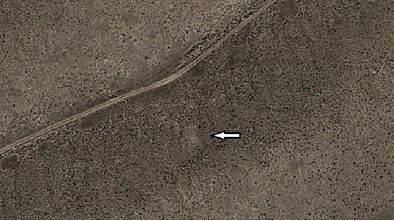
Collecting all the pieces
Another part of the story has to do with the military collecting every scrap of material from the crash site. Despite the massive use of manpower, Bill Brazel claimed he found scraps of the spaceship while riding about on the ranch. This would later be collected by the military, who learned about his souvenirs.
The truth of the matter is that efforts to collect all the material from a military crash site is never 100% effective. Peter Merlin discussed this in his efforts to locate the crash site for a downed A-12 aircraft near Wendover AFB (see his October 2003 article “Oxcart down”). Despite efforts to locate every scrap of debris and hide the impact site, Peter was able to locate all sorts of fragments from the plane. The actual impact crater still can even be seen in aerial photographs (see Google Earth image to the right)!
Dr. Doleman did collect all sorts of objects at the dig site on the Foster Ranch but nothing was shown to be unusual in nature. He would conclude
The project sought to uncover remnants of the two most commonly reported kinds of physical evidence: a furrow and unusual debris. No conclusive evidence of either was found..... 14Dr. Doleman never identified everything that was recovered but also noted none of the debris looked exotic. He did desire to study some of the unidentified debris further but the Sci-FI channel pulled their funding of the project. This may have been a monetary consideration or it is possible they did not want any one to identify the remaining debris as earthly. The failure to find even a small piece of this exotic debris in the soil indicates that such materials may have never existed.
State of the Foster ranch debris site
To date, there have been two scientific attempts to look at the debris field and locate some unusual debris. The CUFOS and the Sci-Fi channel’s expeditions came up empty. Meanwhile, others have been walking over the terrain claiming to find all sorts of things. None of these items have ever been shown to be alien in nature. All of this indicates that the debris field was as described in 1947 - A bunch of earthly debris scattered over a few hundred yards of ground. The lack of any physical evidence to support their existence demonstrates that they are looking in the wrong place or the exotic materials and gouge never existed.
Notes and references
Berlitz, Charles and William Moore. 1. The Roswell Incident. New York: Berkley, 1988. P. 69.
Pflock, Karl. 2. Roswell: Inconvenient Facts and the Will to Believe. Amherst: Prometheus, 2001.P. 230
Stringfield, Leonard. “The UFO Crash/Retrieval Syndrome status report II: New sources, new data part I (continued)”. 3. Flying Saucer Review Vol. 28 No. 3 Available WWW: http://www.ignaciodarnaude.com/ufologia/FSR%201983%20V%2028%20N%203.pdf P. 14.
Berlitz, Charles and William Moore. 4. The Roswell Incident. New York: Berkley, 1988. P. 91.
Ibid. P. 96. 5.
Randle, Kevin and Donald Schmitt. 6. UFO Crash at Roswell. New York: Avon, 1991. P. 130.
ibid. P. 50.7.
Stringfield, Leonard. “The UFO Crash/Retrieval Syndrome status report II: New sources, new data part I (continued)”. 8. Flying Saucer Review Vol. 28 No. 3 Available WWW: http://www.ignaciodarnaude.com/ufologia/FSR%201983%20V%2028%20N%203.pdf P. 15.
Randle, Kevin. “The gouge eliminates the balloon”. 9. The Randle report. Available WWW: http://web.archive.org/web/20000612161730/http://www.randlereport.com/report4.html
Doleman, Willam H., Thomas Carey, and Donald Schmitt. 10. The Roswell dig diaries. New York: Pocket Books. 2004. P. 236-7.
ibid. P. 237.11.
ibid. P. 239.12.
ibid. P. 240.13.
Doleman, William H. “Archeology of the Putative Roswell UFO crash site”. 14. Handbook of space engineering, archeology, and heritage. Boca Raton, Florida: CRC Press. 2009. P. 735.
.
Debris field simulation
.

One of the arguments presented against the Project MOGUL explanation for the Foster Ranch debris is that there would not be enough debris to match the descriptions given. The problem with that argument is that they misrepresent what has been reported by the primary witnesses.
Dense debris concentration?
All the Roswell proponents state that there was a dense concentration of debris at the Foster Ranch but that is not what was stated by Mack Brazel. He described it as:
Brazel said that he did not see it fall from the sky and did not see it before it was torn up, so he did not know the size or shape it might have been, but he thought it might have been about as large as a table top. The balloon which held it up, if that was how it worked, must have been 12 feet long, he felt, measuring the distance by the size of the room in which he sat. The rubber was smoky gray in color and scattered over an area about 200 yards in diameter.1
What about the others, who are known to have seen the debris field:
Bessie Brazel: So much debris scattered over pastureland.2
Jesse Marcel Sr. Scattered all over--just like you’d explode something above the ground and [it would] just fall to the ground. 3
Sheridan Cavitt: Some here, some here, some here. No concentration of it.4
When one examines these descriptions, the word that keeps sticking out is “scattered”. The definitions of the word “scattered” does not imply a dense concentration of anything.
What might have the Mack Brazel debris field looked like?
In an effort to get an idea on what the debris field might look like, I decided to perform a scale simulation in my yard. My yards is 21 yards long, which is 10% of the 200 yards Brazel reported. Based on my measurements of the balloon (which is a 170 gram vice 350 gram balloon) the surface area of a deflated balloon is something like 570 square inches. Assuming there were four balloons worth of material picked up, that means there was something like 2300 square inches of rubber laying about in pieces. One tenth is 230 square inches. I cut up some black strips of paper that I will use to simulate the fragmented balloons. Three ML-307 reflectors are equal to 54 Square feet. Since it is my theory that Marcel found a single reflector a distance away from where Brazel recovered the bulk of the material, I decided to take away one resulting in only 36 square feet of reflector material. This is 3.6 square feet of aluminum foil that was shredded into sizes varying from a few inches to about a foot in size. I included two bamboo sticks. As additional material, I added one black tube for a ballast tube and a ring simulator (using a roll of tape). There may have even been a few other items I did not include (parachute, electrical batteries, transmitter, etc.) but this gives a reasonable scale model of the debris field. To me, the term “scattered” is an accurate description.
Notes and References
“Harasssed rancher who located ‘saucer’ sorry he told about it”. 1. Roswell Daily Record. July 9, 1947. Roswell, NM. Available WWW: http://www.project1947.com/fig/1947f.htm.
Berlitz, Charles and William Moore. 2. The Roswell Incident. New York: Berkley, 1988. P. 96.
Pflock, Karl. 3. Roswell: Inconvenient Facts and the Will to Believe. Amherst: Prometheus, 2001. P 230.
HQ USAF, The Roswell Report: Fact vs. Fiction in the New Mexico Desert. Washington D.C.: US Government, 1995 attachment 4. 18.
-
Quelle: SUNlite 4/2012
